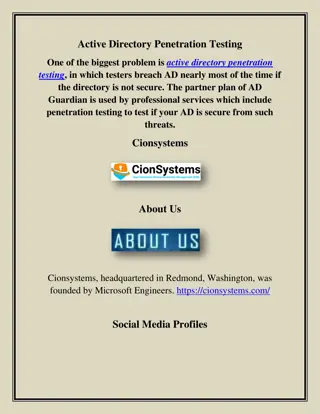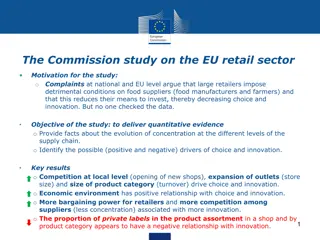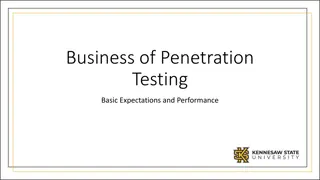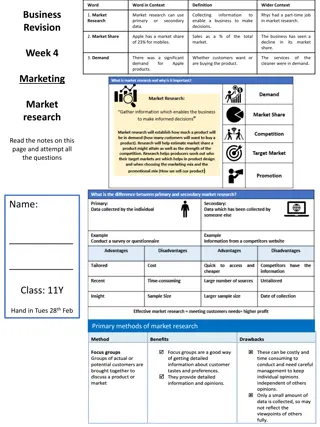
How to Boost Your Business with Effective Market Penetration
Market penetration is a strategy aimed at increasing a companyu2019s market share within existing markets. It involves selling more of the current products or services to existing customers and attracting competitorsu2019 customers.
Download Presentation

Please find below an Image/Link to download the presentation.
The content on the website is provided AS IS for your information and personal use only. It may not be sold, licensed, or shared on other websites without obtaining consent from the author. If you encounter any issues during the download, it is possible that the publisher has removed the file from their server.
You are allowed to download the files provided on this website for personal or commercial use, subject to the condition that they are used lawfully. All files are the property of their respective owners.
The content on the website is provided AS IS for your information and personal use only. It may not be sold, licensed, or shared on other websites without obtaining consent from the author.
E N D
Presentation Transcript
How to Boost Your Business with Effective Market Penetration
Market penetration is a strategy aimed at increasing a companys market share within existing markets. It involves selling more of the current products or services to existing customers and attracting competitors customers. Methods include: Pricing Strategies: Discounts, sales promotions, or volume discounts Increased Marketing: Enhanced advertising and promotional activities Product Improvements: Upgrading existing products to better meet customer needs Distribution Channels: Expanding availability in new regions or through new channels Assessing Your Current Market Position 1. Market Share Analysis: Evaluate the proportion of the market your business holds compared to competitors. 2. Customer Feedback: Gather insights from existing customers regarding your product or service. 3. Sales and Financial Data: Review sales figures, profit margins, and other financial metrics to gauge performance. 4. Market Trends: Stay updated with industry trends to identify potential areas for growth or innovation. Identifying Target Markets Identifying target markets involves comprehensive research and analysis. Businesses must: 1. Conduct Market Research: Gather data on demographics, purchasing behaviors, and preferences. 2. Analyze Competitors: Study competitors to understand their customer base, strengths, and weaknesses. 3. Evaluate Market Needs: Identify the specific needs and pain points of each segment. 4. Determine Market Viability: Assess the potential profitability and scalability of targeting each market segment.
5. Profile Ideal Customers: Create detailed profiles of ideal customers to guide marketing strategies effectively. Conducting Market Research Conducting thorough market research is essential to understand the target audience and identify potential growth opportunities. 1. Identify Objectives: Define the goals of the research, such as understanding customer needs or evaluating competition. 2. Gather Data: Use various methods like surveys, focus groups, and interviews to collect primary data. 3. Understand Market Trends: Keep track of industry trends, technological advancements, and regulatory changes. 4. Segment the Market: Divide the market into distinct groups based on demographics, behaviors, and preferences. 5. Utilize Secondary Data: Utilize existing reports, studies, and data for additional insights. Analyzing Competitors Analyzing competitors is crucial for effective market penetration. Critical steps include: Identifying Key Competitors: Recognize both direct and indirect competitors. Evaluating Competitor Strengths and Weaknesses: Analyze products, pricing, marketing strategies, customer reviews, and distribution channels. Conducting SWOT Analysis: Identify their strengths, weaknesses, opportunities, and threats. Monitoring Market Position and Performance: Track market share, sales trends, and financial health. Investigating Customer Loyalty: Assess customer satisfaction and retention strategies.
These steps provide insights to shape strategies and enhance competitive positioning. Developing a Market Penetration Strategy To create an effective market penetration strategy, businesses should perform thorough market research to understand the competitive landscape. Consider the following steps: 1. Market Analysis Assess competitors strengths and weaknesses. Identify target demographics. 2. Pricing Strategy Implement competitive pricing. Consider promotional pricing tactics. 3. Product Improvement Enhance product features. Incorporate customer feedback. 4. Marketing Campaigns Utilize social media and digital marketing. Focus on targeted advertising. 5. Distribution Channels Optimize existing channels. Explore new distribution partners. Each step requires diligent planning and execution for successful market penetration. Setting Clear Objectives and Goals Establishing clear objectives and goals is fundamental for any successful market penetration strategy.
Steps to Set Clear Objectives 1. Define Specific Goals: Set precise and clear objectives to avoid ambiguity. 2. Align with Business Vision: Ensure that goals support the overall business vision and mission. 3. Set Measurable Targets: Incorporate quantifiable metrics to track progress. 4. Determine Time Frames: Establish deadlines to achieve set objectives. 5. Allocate Resources: Identify and assign necessary resources, such as personnel and budget. With these steps, businesses can systematically pursue and achieve higher market penetration. Optimizing Pricing Strategies Effective pricing strategies are essential for successful market penetration. Businesses need to evaluate various factors to determine optimal pricing. 1. Market Research: Analyze competitor pricing. Assess consumer buying behavior. 2. Cost Analysis: Calculate production costs. Consider variable and fixed costs. 3. Pricing Models: Skimming Pricing: High initial prices to skim maximum revenue layers. Competitive Pricing: Position prices close to competitors. 4. Psychological Pricing: Implement charm pricing (e.g., $9.99). Use tiered pricing to create value perception. 5. Dynamic Pricing:
Adjust prices based on market demand and trends. Thorough analysis and adaptable strategies can significantly boost market penetration. Enhancing Product Offerings To boost market penetration, a strategic enhancement of product offerings is crucial. Businesses should follow these steps: 1. Conduct Market Research: Identify emerging trends and customer preferences. Analyze competitor offerings thoroughly. 2. Innovate and Diversify: Introduce new features or products based on research insights. Diversify the product line to cater to varying segments. 3. Improve Quality and Presentation: Focus on superior product quality. Enhance packaging for better appeal. 4. Utilize Customer Feedback: Collect and analyze feedback regularly. Implement changes to address customer needs more effectively. Expanding Distribution Channels Expanding distribution channels involves diversifying the ways products or services reach customers. Businesses can explore: Retail Partnerships: Collaborating with established retail chains to increase physical presence. Direct Sales Channels: Implementing direct-to-consumer strategies via company websites or branded stores. Third-Party Logistics: Partnering with third-party logistics providers to streamline distribution and manage shipping efficiency.
Franchising: Offering franchises to expand geographically without incurring extensive capital costs. Global Expansion: Assessing and entering international markets to tap into new customer bases. Wholesale Channels: Engaging wholesalers to distribute products to a wider retail network. Utilizing Marketing and Advertising Effective market penetration requires a well-orchestrated blend of marketing and advertising strategies designed to boost visibility, attract potential customers, and establish a strong foothold in the market. To achieve these objectives, businesses must carefully craft their approach, focusing on the following critical tactics: 1. Identify Target Audience: In-Depth Audience Research: To effectively reach your target market, it s essential to conduct thorough research to understand their preferences, behaviors, and pain points. This involves segmenting your audience based on demographics, psychographics, and purchasing habits. Behavioral Insights: Go beyond surface-level demographics by analyzing customer behavior across various platforms. Understanding how your audience interacts with your brand online such as which content they engage with most or what time of day they are most active can inform your market penetration and help you deliver more targeted, effective campaigns. 2. Develop a Strong Value Proposition: Crafting a Unique Selling Proposition (USP): Your value proposition should clearly communicate what makes your product or service unique and why it s the best choice for your target audience. Focus on the specific benefits that set your offering apart from competitors, whether it s superior quality, innovative features, exceptional customer service, or unbeatable pricing. A
compelling USP can be a powerful tool in capturing attention and driving customer loyalty. Emotional Appeal: In addition to highlighting functional benefits, consider how your product or service addresses the emotional needs of your customers. Position your brand as a solution to their challenges, and emphasize the positive impact it will have on their lives. This emotional connection can differentiate your brand and foster a deeper relationship with your audience. 3. Utilize Multiple Channels: Omnichannel Marketing: To maximize your reach and market penetration, it s essential to utilize a variety of marketing channels, including social media, email marketing, content marketing, search engine optimization (SEO), and pay-per-click (PPC) advertising. An omnichannel approach ensures that your brand is visible wherever your target audience is active, providing multiple touchpoints that guide them through the buyer s journey. Content Diversification: For instance, short, engaging videos might perform well on social media, while long-form articles are better suited for your blog. By diversifying your content across channels, you can reach a wider audience and cater to different preferences. 4. Consistent Branding: Unified Brand Identity: Ensure that all marketing materials whether online or offline adhere to your brand s visual identity, tone of voice, and messaging guidelines. This includes using the same logos, color schemes, fonts, and taglines across all platforms. A cohesive brand image reinforces your brand s credibility and makes it easier for customers to recognize and remember you. Cross-Platform Consistency: When running campaigns across multiple channels, ensure that your branding is consistent, yet adapted to each platform s unique context. For example, while the core message should remain the same, the presentation might differ between a LinkedIn post and an Instagram story. 5. Monitor Campaigns:
Real-Time Analytics: To ensure the success of your market penetration and advertising efforts, it s crucial to continuously monitor the performance of your campaigns. Utilize analytics tools to track key metrics such as engagement rates, conversion rates, click-through rates (CTR), and return on investment (ROI). Real-time data allows you to identify what s working and what s not, enabling you to make informed decisions and optimize your strategies on the fly. A/B Testing: Regularly conduct A/B tests to compare different versions of your ads, emails, or landing pages. This process helps you determine which elements such as headlines, visuals, or calls to action are most effective in driving conversions. 6. Personalization and Customer Engagement: Tailored Marketing: Personalization is a powerful tool in modern marketing. By leveraging customer data, you can create personalized experiences that cater to individual preferences and behaviors. This might include personalized email campaigns, product recommendations based on past purchases, or targeted ads that reflect the user s interests. Interactive Content: Polls, quizzes, contests, and interactive infographics can engage your audience more effectively than static content, driving higher engagement and fostering a more meaningful connection with your brand. 7. Customer Feedback and Adaptation: Listening to Your Audience: Regularly seek feedback from your customers to understand their needs, preferences, and pain points. Listening to your customers allows you to adapt your marketing strategies to better meet their expectations, which can lead to higher customer satisfaction and loyalty. Iterative Improvements: Use customer feedback to make continuous improvements to your products, services, and marketing campaigns. An iterative approach ensures that your brand stays relevant and responsive to the evolving needs of your market. 8. Strategic Partnerships and Collaborations:
Expanding Reach: Partnering with other businesses, influencers, or industry leaders can help you reach new audiences and enhance your market penetration efforts. Strategic collaborations can involve co-branded campaigns, joint promotions, or influencer endorsements that align with your brand values and goals. Utilizing Partner Networks: By tapping into your partners networks, you can introduce your brand to a broader audience that may not have been accessible otherwise. This can accelerate market penetration and establish your brand in new segments. By focusing on these key areas, businesses can create impactful campaigns that resonate with their audience and drive market penetration. Monitoring and Adjusting Strategies Effective monitoring is crucial for successful market penetration. Businesses should: Track relevant KPIs such as sales volume, market share, and customer acquisition rates. Utilize analytics tools to gather real-time data on consumer behavior and trends. Conduct regular competitor analysis to stay ahead of market dynamics. Additionally, adjusting strategies might involve: Tweaking marketing tactics based on performance analytics. Diversifying product or service offerings to better meet market demands. Revisiting pricing models to ensure competitiveness. Enhancing customer service to improve satisfaction and retention. Consistent evaluation and adaptability are key.






















